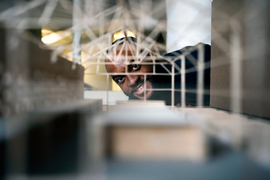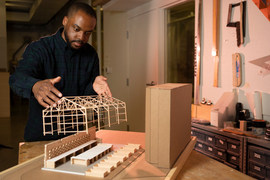Justin Brazier didn’t always know that his path in life would take him right back home.
Brazier grew up with two brothers in a tight-knit family in Randolph, Massachusetts, two cities south of Boston. His parents, who are Haitian immigrants, had also grown up in the Boston area and met each other there.
From a young age, Brazier loved to draw. But when it came time for college, he didn’t think he could get a viable job as an artist. Instead, he searched for other exciting careers, hopping between colleges in and out of the Boston area and cycling through numerous majors, from engineering to business to chemistry. But he had no luck with finding a match.
Finally, after years of searching, “I bit the bullet to pursue art,” figuring that even “if I don’t make any money, at least I’ll be happy,” he says. Brazier returned to Boston to study at the Massachusetts College of Art and Design. At first, he pursued industrial design with the goal of designing sneakers. But then, some of his professors encouraged him to look into architecture, where he could develop a broader skill set. “I took some classes and everything clicked,” he says.
Brazier’s interest in architecture solidified during his undergraduate studies when he joined the Farmers Collaborative, a Boston-based group that works with city officials to turn vacant lots into urban agricultural centers. Brazier started off designing garden grow beds for the collaborative’s projects, working with co-founders CJ Valerus and Leon David. These grow beds became a food source in the Boston community and helped ease food insecurity. Through this work and his studies, “I realized the ability architects have to shape the environment. The design of greenhouses and farming structures can connect people with their history and culture,” he says.
After graduating, Brazier continued to work with the Farmers Collaborative, while keeping a full-time job. With only a bachelor’s degree in architecture, though, he was limited in how far he could push projects forward. To fully realize a project on his own, he would need a professional license. Because of this, “I always knew I wanted to go to grad school to become a full architect,” Brazier says. After taking a couple of years off from school to work, he joined MIT’s MArch program.
Brazier plans to use his expertise as a licensed architect to help communities, especially those of color, transform neighborhoods through urban agriculture and food sovereignty. This goal, rooted in his childhood and family background, is “really important to me,” he says.
A new community greenhouse underway
While pursuing his master’s, Brazier has stayed involved with the Farmers Collaborative. He is currently working on a project with Velarus and David to build a year-round greenhouse in Mattapan, a neighborhood of Boston with a large Haitian population, where his dad grew up. Brazier has also brought professor and licensed architect Sheila Kennedy, his mentor at MIT, on board to help with the project.
A major goal of the greenhouse project is to improve food security in Mattapan through urban agriculture. Brazier is taking a holistic approach to the project, informed by the neighborhood’s input. “We’re thinking about the agricultural process in a full cycle, where we have pollination to food growth to composting,” he says. Besides the main greenhouse, the community space will have a bee apiary, several outside grow beds, and a composting area.
The space will also serve as a place for the community to get together. People can relax in the patio seating area or host an open-air farmer’s market out back. Brazier also hopes to introduce educational programs in the space for kids to learn about agriculture and climate. “We want to create a space that contributes to the overall sustainability of the neighborhood, culturally and socially,” Brazier says.
The greenhouse will sit on a corner lot on the highly trafficked Morton Street. The lot is a short five-minute walk from the street’s major intersection with Blue Hill Avenue. “It’s a prominent area that can really show off what the community is able to do,” Brazier says.
Prior to the Morton Street project, Brazier worked on a similar project with the collaborative to build a greenhouse in Dorchester, a neighborhood adjacent to Mattapan that is also home to a large Black community. The previous project, coordinated by architect Wyly Brown and graduate students from MassArt, called the HERO Hope Garden, is located on Geneva Avenue in the heart of Dorchester. At the center of the Garden is a wooden greenhouse with an angled slatted roof, flanked by several grow beds and open patio seating with a painted mural backdrop. “Everyone loves it,” Brazier says. “It’s helped the community to grow food to stave off food insecurities, especially during Covid.”
Brazier and the Collaborative are using the HERO Hope Garden as a template for the Morton Street project, carrying over its successes and making strategic improvements. For example, although the garden’s wooden greenhouse is fully enclosed, animals and cold winter air still find their way inside. For the Morton Street project, “it’s going to be steel construction, which is a lot more robust,” he says. “And it’s going to be completely weather tight to work through all seasons” for increased food production.
To make this community project possible, the city of Boston is providing funding through the Mayor’s Office of Housing and the Community Preservation Act. But “to realize the project in full,” there’s still “a little bit of a funding gap,” Brazier says. He and the collaborative are currently looking for additional funding to close this gap and ensure the community can have all of the project’s planned features.
In the meantime, with most of the funding nailed down, construction on the Morton Street project will start this summer, with plans for completion next summer.
Empowering communities to bring their ideas to life
While Brazier has been heavily involved with urban agriculture projects these past few years, he ultimately sees himself playing a broader role in the community. He’s noticed that when people, especially those of color, have ideas to upgrade their neighborhoods, they often struggle to push their ideas forward. “People want to propose different things to the city but don’t have the skill set or language” and need an architect’s help, he says. But for many people of color, an architect “feels like somebody they can’t really approach” because they don’t know any or can’t identify with them.
That’s where Brazier comes in. Having roots in the Greater Boston area makes him more approachable to people in these communities. Brazier has gotten calls to help put together proposals for the Mattapan area and beyond, including turning an abandoned building into a café, putting up art installations in alleyways, and conducting design studies for first time developers looking to build local ownership within their neighborhoods. His plans and renderings have helped people start conversations with city officials about their ideas, opening doors even if the projects don’t pan out.
Last year, some people Brazier had grown up with reached out to him for help with renovating their sneaker store in Randolph. Brazier worked on the interior design of the store, named Kerms. Located near Randolph High School, Kerms now sets an inspirational example for kids in the community, showing them that “they can stay in Randolph and have ownership,” he says.
Brazier is happy that he’s in a place where people feel comfortable asking him for design help that he can provide. At the end of the day, all he wants to do is “empower people to develop their own environments and put their fingerprints on their own neighborhood,” he says.















